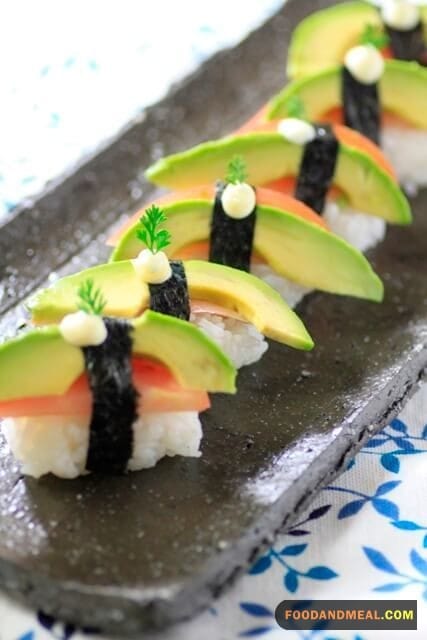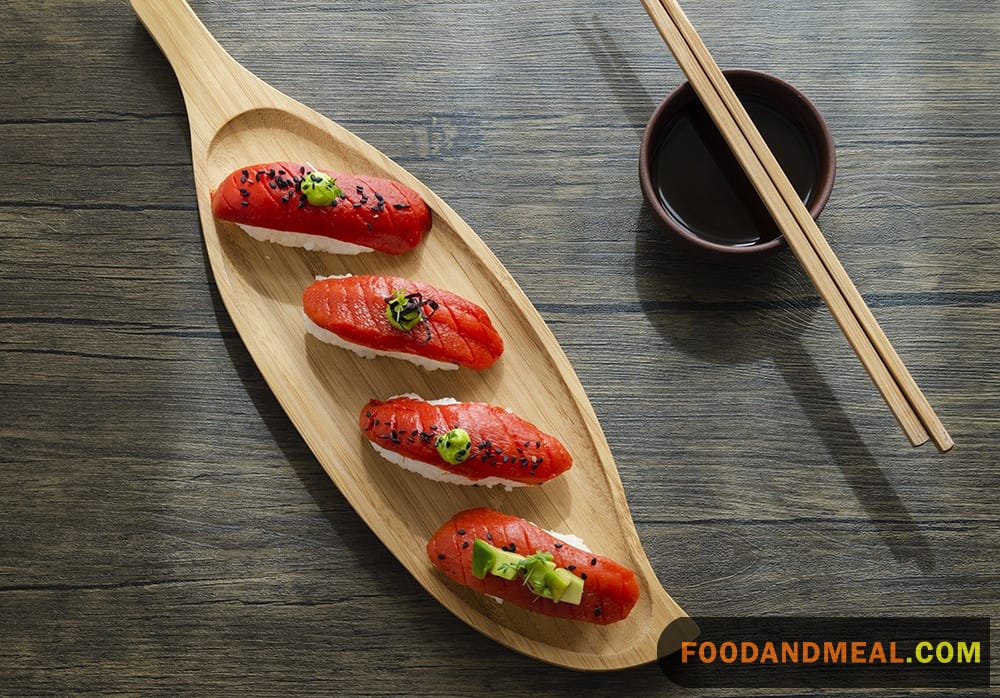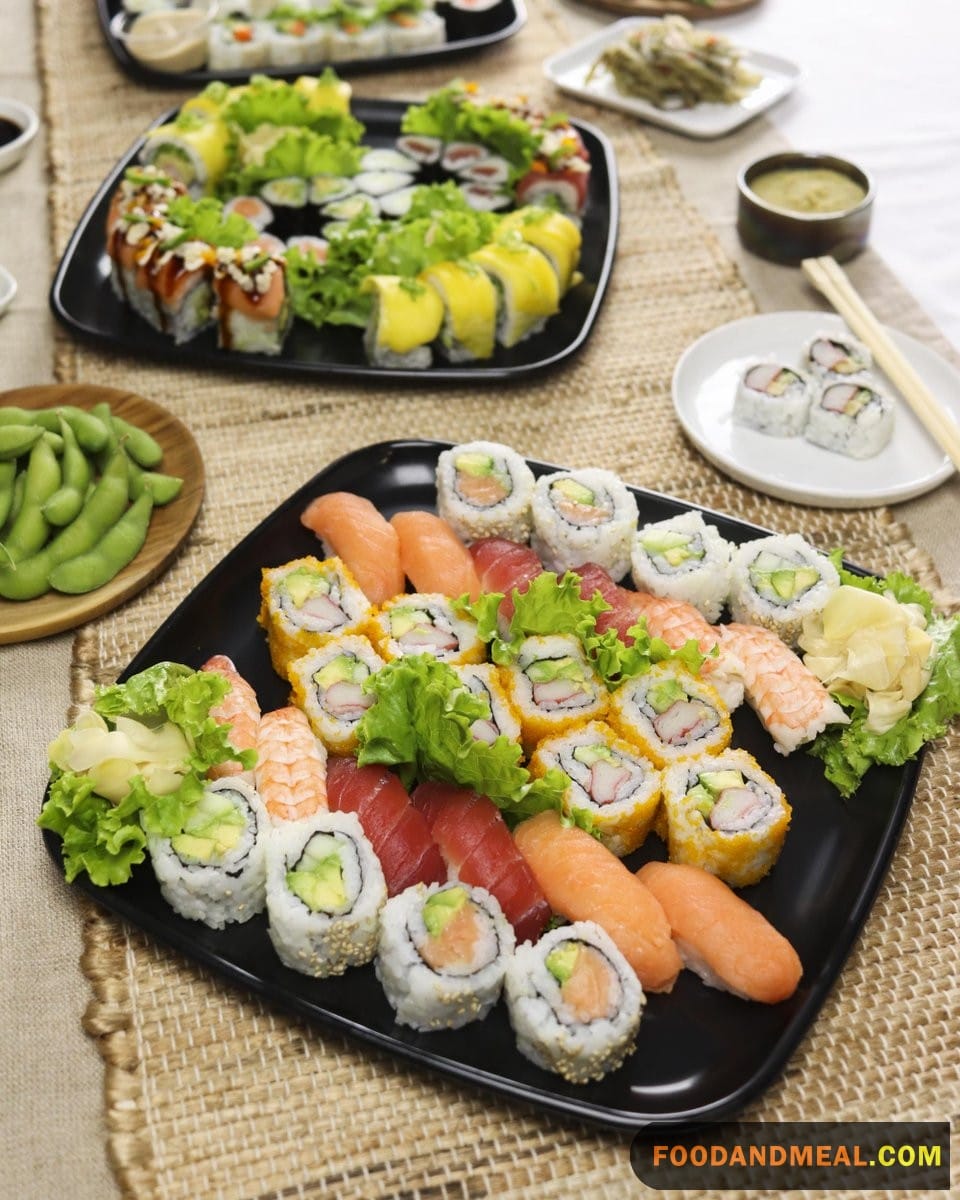While the Japanese are famous for their fish, vegetarians can enjoy sushi as well. Nigiri is a popular dish in Japan that consists of vegetable pieces pressed into sticky rice. The rice is held together by a band of dried seaweed. Vegetarian nigiri is a great choice for those who are vegan or have a vegetarian diet. It is also available at many Japanese restaurants.
As a father of two growing girls, I often ponder what kind of world I want them to grow up in. When I think about the future, I can’t help but consider the impacts of climate change, environmental degradation, and issues around ethics and sustainability. This is what originally drew me to explore vegetarianism and adopting more planet-friendly eating habits.
I’ll never forget the first time I tried a vegetarian sushi roll. The combination of flavors and textures was so unexpectedly delightful! The sweetness of the bell peppers, the umami burst from the tamari-infused rice, the crunch of the sesame seeds… it opened my eyes to the possibilities of plant-based cuisine. Ever since that fateful veggie roll, I’ve been hooked on meatless sushi alternatives.
Now I’m excited to try my hand at making vegetarian nigiri sushi at home. Crafting those petite parcels of rice and produce seems like an elegant art that would be satisfying to master. I love that it’s a healthy option I can share with my family, free from concerns about environmental toxins that can accumulate in fish. Exploring new vegetarian recipes allows me to live out my values around compassion and care for our planet. Plus, the vibrant colors are sure to delight my girls!
“I invite you to join me on this journey of discovering how flavorful and fulfilling plant-based cooking can be. Let’s craft some vegetarian nigiri sushi together and answer the question, ‘Can Vegetarians Eat Sushi?‘”
What is vegan nigiri made of?
Vegan nigiri, a delightful twist on traditional Japanese sushi, is a testament to the creativity and ingenuity of plant-based cuisine. This elegant and impressive dish is simple to make, yet it carries with it an air of sophistication that can elevate any dining experience.
At the heart of vegan nigiri lies the vibrant red bell pepper fillets, which are marinated in a salty seaweed sauce, infusing them with a depth of flavor that is both surprising and satisfying. The peppers are transformed through this process, taking on a tender texture that mimics the delicate feel of raw fish typically found atop nigiri. It’s a beautiful deception for the palate, offering a burst of umami that dances across the taste buds.
The preparation of vegan nigiri is almost meditative, requiring a gentle touch and a bit of patience as you marinate the peppers and carefully form the sushi rice into perfect, bite-sized mounds. There’s a sense of pride that comes with crafting each piece, knowing that it’s not only a feast for the eyes but also kind to the planet.
Serving this plant-based wonder with a dollop of wasabi adds a fiery kick that awakens the senses, creating a harmonious balance with the savory notes of the marinated peppers. It’s a culinary adventure that’s both bold and nuanced, leaving you with a lingering warmth and a craving for just one more piece.
As someone who appreciates the art of sushi-making, I find vegan nigiri to be a joyful celebration of flavors and textures. It’s a dish that proves you don’t need to rely on seafood to enjoy the essence of traditional sushi. Instead, it invites you to explore the vast possibilities of vegetables, showcasing how they can be the stars of the show.
In a world where we’re becoming increasingly conscious of our food choices and their impact on the environment, vegan nigiri stands out as a beacon of sustainability and compassion. It’s a small act of rebellion against the norm, a delicious defiance that says, “Yes, we can have our sushi and eat it too—without harm.”
So, whether you’re a seasoned vegan or simply curious about plant-based alternatives, vegan nigiri is a dish that will surprise, delight, and perhaps even inspire. It’s a reminder that in the realm of food, there are endless opportunities to innovate and enchant, all while honoring the earth and its inhabitants. “Can Vegetarians Eat Sushi” now extends to the world of vegan nigiri, proving that delicious and sustainable options are within reach for every palate.
What types of sushi are vegetarian?
Sushi, a culinary art form that has transcended its Japanese origins, is often associated with fresh fish and seafood. However, the world of sushi is not limited to the pescatarian palate; it offers a delightful array of vegetarian options that cater to the herbivorous among us. As someone who revels in the vibrant colors and textures of plant-based cuisine, I find vegetarian sushi to be an exciting and satisfying experience.
The sheer variety of vegetarian sushi is a testament to its versatility. Inari sushi, with its sweet and tender tofu pockets cradling seasoned rice, is a personal favorite. It’s like a little gift from the kitchen, each bite a perfect balance of flavors. Avocado sushi, with its creamy texture and rich taste, is another staple that never fails to please. The buttery avocado paired with the tang of rice vinegar creates a simple yet profound flavor profile.
For those seeking a crunch, cucumber sushi, known as kappamaki, is a refreshing choice. The crispness of the cucumber wrapped in a snug blanket of rice and seaweed is both invigorating and cleansing to the palate. Aubergine sushi brings a smoky depth, while the bright notes of pickled radish in takuan maki offer a zesty contrast.
Exploring further, one can find the earthy umami of shiitake mushroom nigiri, the subtle sweetness of nasu nigiri made from eggplant, and the comforting warmth of tamagoyaki nigiri, a type of sweet omelet. Each piece of sushi is a small work of art, crafted with care and precision, offering a unique blend of textures and tastes.
Vegetarian sushi is not just about the absence of fish; it’s a celebration of the bounty of the earth. It’s about the joy of discovering new combinations and the satisfaction of a meal that is both wholesome and delicious. Whether you’re a lifelong vegetarian or simply looking to expand your culinary horizons, vegetarian sushi is a delightful journey through flavor and tradition, proving that sushi can indeed be a plant-lover’s dream. “Can Vegetarians Eat Sushi” is a question answered with a resounding yes in the world of delicious and diverse vegetarian sushi.
Best Vegetarian Nigiri Recipes


Vegetarian Nigiri
Equipment
Ingredients
- Sushi rice
- 1 small zucchini sliced very thinly (paper-thin)
- 1 small slice green shiso or perilla, cut lengthwise and in small diagonal strips
- ¼ nori seaweed cut into about M-inch wide strips
- Wasabi
- Salt
- Sushi vinegar
- Hot sauce
Instructions
- Sprinkle the zucchini slices generously with salt. Rub it in, and leave it to sit until the turnip has wilted. Rinse and drain, and squeeze out the water.
- In a wok, warm the oil and quickly stir-fry the zucchini. Remove from wok and place on paper towels to absorb excess fat.
- Take a scoop of sushi rice to fit your fist. Pack the rice in your fist to make a small rectangle.
- Smear on a dab of wasabi paste, and place piece of shiso leaf on top.
- Dip 2-3 slice of zucchini in sushi vinegar, lay it on the rice, and adjust the shape.
- Wrap a strip of nori like a belt around its width, tucking the ends underneath.
- If desired, place a dab of hot sauce on top and serve.
Notes
Nutrition
© Food And Meal
This website provides approximate nutrition information for convenience and as a courtesy only. Nutrition data is gathered primarily from the Spoonacular Database, whenever available, or otherwise other online calculators.
Alternative Method: Vegetarian Nigiri Rice Bowls

Ingredients:
- 2 cups sushi rice
- 1/4 cup rice vinegar
- 2 tablespoons sugar
- 1/2 teaspoon salt
- Assorted fresh vegetables (e.g., cucumber, avocado, carrot, bell pepper), thinly sliced or julienned
- Nori (seaweed) sheets, toasted and cut into thin strips
- Pickled ginger
- Wasabi
- Soy sauce
- Sesame seeds for garnish
Instructions:
- Prepare Sushi Rice: Rinse the sushi rice under cold water until the water runs clear. Cook the rice in a rice cooker following the manufacturer’s instructions. While it’s hot, transfer it to a large bowl.
- Season the Rice: In a small saucepan, combine the rice vinegar, sugar, and salt. Heat over low heat, stirring until the sugar and salt dissolve. Pour this seasoned vinegar mixture over the cooked rice and gently fold it in. Allow the rice to cool to room temperature.
- Assemble the Rice Bowls: In individual serving bowls, place a generous portion of seasoned sushi rice. Arrange the sliced vegetables on top, followed by the toasted nori strips.
- Garnish and Accompaniments: Sprinkle sesame seeds over the rice bowls for added texture and flavor. Serve with pickled ginger, wasabi, and soy sauce on the side.
- Customize Your Bowls: Encourage personalization by allowing each diner to tailor their Vegetarian Nigiri Rice Bowl with their preferred vegetables and condiments.
Tips for making Vegetarian Nigiri

Serving Suggestions
- Serve the vegetarian nigiri alongside a fresh green salad with ginger soy dressing or miso tahini dressing for a light and nutritious meal. The tangy dressings would pair nicely with the sweet and savory nigiri.
- For a heartier meal, make vegetarian sushi bowls with rice, roasted vegetables like kabocha squash or carrots, avocado, and tofu. Top with the assorted nigiri sushi pieces.
- Try rolling the vegetarian nigiri fillings like marinated tofu or sweet potato tempura into maki sushi rolls. Serve with soy sauce, wasabi, and pickled ginger.
- For a fun presentation, serve the nigiri on a bed of fresh salad greens, diced mango and avocado for a colorful tuna-inspired platter.
- Make it a soup and sushi night by pairing miso soup or spinach and clam soup alongside the assorted vegetarian nigiri pieces.
- For a Japanese-inspired breakfast, serve the nigiri with tamagoyaki rolled omelets, natto fermented soybeans, and Japanese vegetable pancakes.
Cooking Tips

- Perfectly Seasoned Rice: Achieving perfectly seasoned rice is key. Ensure your sushi rice is thoroughly seasoned with vinegar, sugar, and salt. Taste as you go to get the balance just right.
- Precise Slicing: When slicing vegetables, aim for uniform, thin pieces. This ensures that each bite is a harmonious blend of flavors and textures.
- Keep the Nori Crisp: To keep the nori crisp and avoid sogginess, assemble the Nigiri just before serving. Wet hands slightly when handling the rice to prevent it from sticking.
- Freshness is Key: The success of your Vegetarian Nigiri relies on fresh, high-quality ingredients. Explore a variety of vegetables to find your preferred combination.
- Practice Makes Perfect: Crafting Nigiri may take some practice. Don’t be discouraged if your first attempts aren’t picture-perfect. With time, your skills will grow, and the results will be even more delicious.
FAQs about Vegetarian Nigiri

- What is the difference between sushi and nigiri?
- Answer: Sushi is a broad term that encompasses various dishes made with vinegared rice, while nigiri specifically refers to a type of sushi consisting of a small bed of rice topped with a slice of fish or other ingredients.
- Is nigiri always salmon?
- Answer: No, nigiri can feature various toppings, not limited to salmon. It can include a variety of fish, seafood, or even vegetarian options.
- Can I use regular short-grain rice for Vegetarian Nigiri?
- Answer: While short-grain rice is commonly used in sushi, it’s recommended to use sushi rice (Japonica rice) for the best results in Nigiri. The stickiness and texture of sushi rice contribute to the ideal Nigiri experience.
- How do I store leftover Vegetarian Nigiri?
- Answer: Leftover Nigiri should be stored in an airtight container in the refrigerator. For optimal freshness, consume it within 24 hours.
- Can I make Vegetarian Nigiri in advance for a party?
- Answer: It’s best to assemble Vegetarian Nigiri just before serving to maintain the crispness of the nori. However, you can prepare the seasoned rice and vegetables in advance to save time.
- Are there gluten-free soy sauce options for dipping?
- Answer: Yes, gluten-free soy sauce is available and serves as a suitable alternative for those with gluten sensitivities.
- Can I substitute the rice vinegar in the rice seasoning?
- Answer: While other vinegars can be used in a pinch, the authentic taste of Vegetarian Nigiri is best achieved with rice vinegar. It provides a distinct flavor that complements the dish.
Conclution
In closing, I’m thrilled to have taken my first steps on this journey of discovering vegetarian nigiri. Crafting those petite parcels of rice and vibrant produce brought me joy, sparked my creativity, and let me share wholesome flavors with my family. I plan to continue experimenting with meatless sushi options, perhaps trying my hand at rolls featuring sweet potatoes, avocado, or marinated tofu next. My hope is that little by little, more people will come to appreciate plant-based cuisine not just for health reasons but for the artistry and compassion behind it. If we care about building a sustainable future, shifting towards more vegetarian meals can nourish both our bodies and spirits. I invite you to join me on this flavorful quest – let’s keep innovating with compassion!


